Musicians are often told they should “learn intervals”. We are told this by our instrument teacher to help us pass exams, by course professors at music college, by ear training tools and websites…
But why? What is so important about intervals – and if you do want to learn them, how exactly do you do interval ear training?
An interval is simply a pair of notes. More specifically it’s the distance between those two notes.
Here’s another one:
Put them together and you have an interval:
So what’s the big deal?
When you first encounter them like this, intervals can seem pretty dull! They seem like an abstract (and apparently pointless) part of music theory. Not only that, but when musicians start trying to learn them, most find it repetitive and frustrating…
So why do you always hear the advice to “learn intervals”?
In this guide we’re going to explain intervals from the very beginning.
We’ll explain:
- What intervals are and why they matter,
- What it means to “learn intervals”,
- Three different methods you can use to learn them, and
- How learning intervals will actually help you as a musician.
There’s a lot to cover! That’s why for each of the points covered in this guide you’ll find the full explanation, and then a simple short summary below marked in blue like this:
An interval is the distance in pitch between two musical notes.
Feel free to read the full explanations, read only the short summaries, or do a mix of both depending on which parts are most interesting and relevant to you.
Let’s get started!
Contents
- About Intervals
- Learning Intervals
- How is it possible to recognise intervals?
- How can I learn to recognise intervals?
- What are the most important intervals?
- What are “compound” intervals and do I need to learn them?
- Where can I find good interval reference songs?
- How can I learn intervals with solfa?
- How can I learn intervals by just doing it?
- Do I need to master certain intervals before moving on?
- What if I get stuck learning intervals?
- Why does singing intervals help you learn them?
- Using Intervals
 About Intervals
About Intervals
What is an interval?
 Every note in music has a pitch: how high or low it is. That means that between any two notes there is a difference in pitch. Some notes are the same pitch or close together while others are further apart.
Every note in music has a pitch: how high or low it is. That means that between any two notes there is a difference in pitch. Some notes are the same pitch or close together while others are further apart.
Think of a piano keyboard. The leftmost notes are low in pitch, the rightmost notes are high in pitch. The further apart two keys are physically, the further apart their pitches are.
We call the pitch distance between two notes the interval between them. You can learn to recognise these different distances by ear, which is called “learning intervals” or “learning interval recognition”.
An interval is the distance in pitch between two musical notes.
What’s the point of learning intervals?
Intervals are often recommended as the place to start with ear training. Unfortunately students are rarely told why they should bother learning interval recognition. When intervals are taught in a dry, music-theory way, they seem like useless abstract things.
This is a pity because learning intervals is powerful. What you need to know is that they’re a means to an end. Recognising a pair of notes as a “perfect fifth” might be a neat party trick but it’s not all that useful. However when you learn to recognise intervals like that you are developing your core sense of relative pitch.
 Relative pitch is what lets you to judge the distances in pitch between notes. In melodies, in chords and progressions, even in complex orchestral arrangements.
Relative pitch is what lets you to judge the distances in pitch between notes. In melodies, in chords and progressions, even in complex orchestral arrangements.
Have you ever wondered how musicians can play songs by ear, improvise powerful solos, and write down the music they hear in their head or in the real world?
The answer is they’re using a well-trained sense of relative pitch.
Intervals are the building blocks of relative pitch. So learning interval recognition will give you that core musical instinct for pitch which lets you do all kinds of exciting practical things in your musical life.
(Still not convinced? Read our full article: Interval Ear Training: what’s the point?)
Intervals are the building blocks of your sense of relative pitch, which lets you hear the pitch distances between notes. Relative pitch is how you play by ear and improvise.
What is “interval recognition”?
“Recognising intervals” means that when you hear a pair of notes in music you know the type of interval between them. Each “type” of interval has a name and by recognising the type of interval, you are actually recognising how far apart two notes are in pitch.
When people say “interval ear training” they are referring to this process of learning to recognise intervals.
As you first practice recognising intervals it starts out as a very abstract theoretical exercise. You play a pair of notes and try to judge what interval (i.e. pitch distance) is between them. Over time as you get better at this it becomes more automatic and instinctive, until you can hear a whole set of notes (e.g. in a chord, or one-by-one in a melody) and know what the notes are without necessarily thinking through the name of each interval.
Recognising an interval means that you hear a pair of notes and you know how far apart in pitch they are. There are different names for the different distances.
What are the different types of interval?
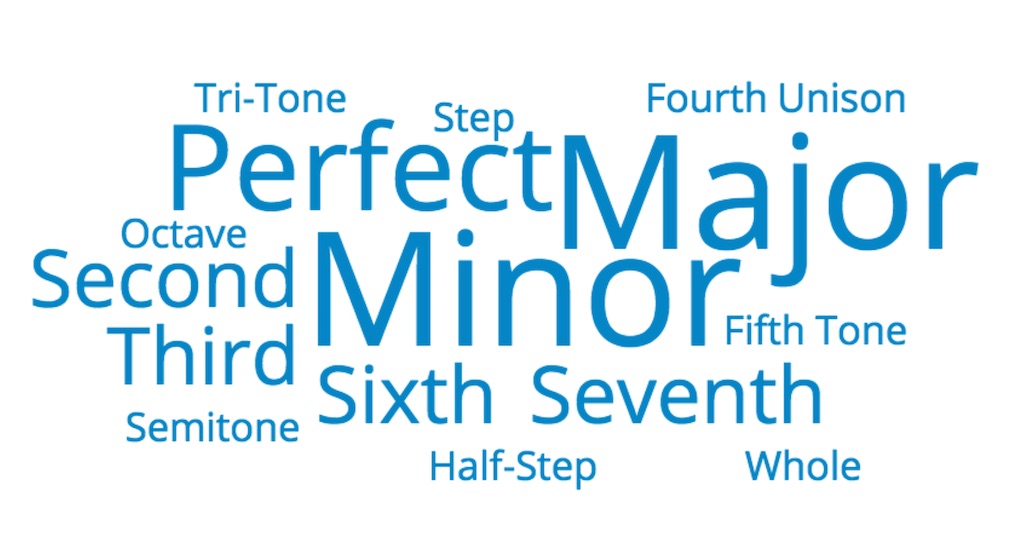 As discussed above, the names of the different “types” of interval are simply a shorthand for different pitch distances. For music theory reasons, instead of saying “this one is 1 unit of pitch from that one”, “that interval one is 3 units of pitch”, etc. we actually give the interval types more distinctive and useful names.
As discussed above, the names of the different “types” of interval are simply a shorthand for different pitch distances. For music theory reasons, instead of saying “this one is 1 unit of pitch from that one”, “that interval one is 3 units of pitch”, etc. we actually give the interval types more distinctive and useful names.
Specifically, we name interval types by their degree in the musical scale and their “quality” which produces names like “Major Third” and “Perfect Fifth”. Each name has those two elements: quality and degree.
- The degree is simple numbering from one to seven, for the seven distinct notes in a major or minor scale.
- The quality of an interval is most commonly “major”, “minor” or “perfect” but can also be “augmented” or “diminished”.
Here’s the full list of the most common interval types you’ll encounter. The number is the number of “pitch units” (actually called “semitones” or “half steps”) each one represents. Some have different names in different countries or traditions – choose whichever you prefer or is familiar.
- Unison
- Semitone, Half-Step, or Minor Second
- Tone, Whole Step or Major Second
- Minor Third
- Major Third
- Perfect Fourth
- Tri-Tone
- Perfect Fifth
- Minor Sixth
- Major Sixth
- Minor Seventh
- Major Seventh
- Perfect Octave
Some pitch distances actually have multiple names from a music theory perspective, but for recognition and listening skills you don’t need to worry about that.
There are 13 main types of interval, named for the scale degree they correspond to (e.g. “third”, “fourth”, “fifth”) and their “quality” which is normally “major”, “minor” or “perfect”.
What music theory do I need to know?
There’s a lot of music theory behind intervals. You can go deep into where they come from, how they relate to keys, scales, chords, and progressions, how to invert intervals, how intervals are used in harmony, composing and arranging, and so on.
But to actually make use of interval recognition in a practical way you need to know almost none of that.
 One common rabbit-hole is worrying about the “spelling” of intervals. For example, trying to memorise that a perfect fifth above a C is a G, and a major third below a C is an A♭, how to work out the interval name from a pair of note names etc.
One common rabbit-hole is worrying about the “spelling” of intervals. For example, trying to memorise that a perfect fifth above a C is a G, and a major third below a C is an A♭, how to work out the interval name from a pair of note names etc.
This is a useful skill at times, particularly if you’re working a lot with traditional notation (e.g. trying to sight read music in choir). However, don’t make the mistake of feeling you need to memorise the spelling of every interval in every key to progress with interval recognition.
If you learn the basic music theory behind intervals you can always work out the answer to those kinds of question methodically, and you can start using intervals in your playing without knowing all the spellings. For example, see the explanations below about how to use intervals to improvise or play by ear.
Learn the spellings and deeper theory only as you need it.
Just learn the names of each interval type. You can learn lots of detailed theory and how to “spell” each interval in each key, but you don’t need to in order to benefit from learning interval recognition.
What are “melodic” and “harmonic” intervals?
These are two terms you may hear and it’s important to understand that they are simply different ways of playing the same type of interval.
- An interval in “melodic” form means its two notes are played one after the other. An example would be the first two notes of a musical tune, or the beginning of a scale you play on your instrument. Naturally, the first note can be above or below the other, so melodic intervals can actually be “ascending” or “descending”.
Here’s an ascending perfect fourth:Here is the same interval descending:
- An interval in “harmonic” form means its two notes are played at the same time. An example would be two notes of a chord, or two singers singing a note at the same time in a duet.
Here is the same interval as above, in its harmonic form:
When you learn interval recognition you should practice with all three forms. Fortunately, studying each form helps with the others. For example, as you get better with harmonic major thirds, you will find that ascending and descending major thirds get easier to recognise too.
“Melodic” means played one note at a time, either ascending or descending in pitch. “Harmonic” means both notes are played together.
 Learning Intervals
Learning Intervals
How is it possible to recognise intervals?
There are two ways that your brain learns to recognise different types of interval:
- By hearing the characteristic sound of the interval. For example, “major” intervals tend to sound happier and brighter than “minor” intervals. Example:
Major third:
Minor third:
There are also other aspects which can make intervals distinctive, for example some have a clashing, uncomfortable sound, while others sound comfortable and at rest.
 By directly estimating the distance in pitch. For example, most musicians could tell you that the notes of a major sixth are further apart than the notes of a major second:
Major second:
By directly estimating the distance in pitch. For example, most musicians could tell you that the notes of a major sixth are further apart than the notes of a major second:
Major second:Major sixth:
You can refine this ability to judge pitch distances by practicing interval recognition.
These two approaches work together. At different stages of your training and in different circumstances you’ll use one skill more than the other.
For example, the characteristic sounds tend to be helpful when first starting out but mostly for harmonic intervals. Judging pitch distances can be hard for adjacent types of interval (e.g. major third vs minor third) but this skill gets stronger with practice and is ultimately the more useful and instinctive version of the skill. It’s like having an innate pitch ruler in your head.
Your ear recognises different types of interval by their distinctive sound and/or by the raw size of them.
How can I learn to recognise intervals?
There are three ear training methods musicians use to learn interval recognition.
 The first method is “reference songs”. This means that for each type of interval, you memorise a song melody which has that interval as its first two notes. You normally choose songs which are already familiar to you. The idea is that when you hear the interval, your brain automatically fills in the rest of the melody after, and by recognising the melody you recognise the interval.
The first method is “reference songs”. This means that for each type of interval, you memorise a song melody which has that interval as its first two notes. You normally choose songs which are already familiar to you. The idea is that when you hear the interval, your brain automatically fills in the rest of the melody after, and by recognising the melody you recognise the interval.
This method is the one usually used when music students are forced to learn interval recognition just for the “aural skills” section of their instrument exams. It’s actually a great way to get started, but you will quickly realise it is very limited for real music applications where you can’t recognise each song for each pair of intervals quickly enough. It’s also not great for harmonic intervals.
 The second method is “solfa”. This is the “do re mi” approach made famous by the childrens song in The Sound of Music. But don’t let that fool you. Solfa (also called “solfege”) is probably the most powerful and versatile framework there is for learning relative pitch. There’s a bit of a learning curve but if you’re truly dedicated to developing your musicianship solfa is a great choice.
The second method is “solfa”. This is the “do re mi” approach made famous by the childrens song in The Sound of Music. But don’t let that fool you. Solfa (also called “solfege”) is probably the most powerful and versatile framework there is for learning relative pitch. There’s a bit of a learning curve but if you’re truly dedicated to developing your musicianship solfa is a great choice. The third method is to just do it, by drilling interval recognition exercises and listening carefully to hear how the different types of interval compare. This is the most common approach among musicians. It’s a “brute force” approach, meaning it can be a bit dull – but it is simple and effective.
The third method is to just do it, by drilling interval recognition exercises and listening carefully to hear how the different types of interval compare. This is the most common approach among musicians. It’s a “brute force” approach, meaning it can be a bit dull – but it is simple and effective.
You can learn more about all three approaches in our full article How to learn intervals.
There are three methods for interval ear training. Start with reference songs, then move on to solfa (do-re-mi) or pure recognition drills.
What are the most important intervals?
As you saw in the list above, there are 13 types of interval and they come in three different forms (ascending, descending and harmonic). In fact there are even more types than that (see “compound intervals” below).
So how do you know what to focus on?
You don’t need to worry about mastering them all. In fact, just half of those 13 types are the most important.
- Start by learning major and minor seconds, because they are the “stepping stones” the other intervals are built from and they’re the most common interval used between notes in melodies.
- Learn major and minor thirds because they’re important for chords and harmony (and also common in melodies).
- Learn perfect fourths and fifths because they’re important for harmony and especially for chord progressions.
The octave is important too, but most musicians find that comes fairly easily.
You should study all three forms, and it’s normally best to practice with the different forms of one type of interval fairly close together. For example don’t ignore all the intervals’ harmonic forms until after you’ve mastered them all in melodic form. It’s normally easier if your plan has you practicing the harmonic form soon after the melodic, or vice-versa.
Naturally it is helpful to eventually learn every type of interval but focusing on the types listed above will help you get practical results from your practice as soon as possible.
Learn seconds for melodies (and everything), thirds for chords and fourths/fifths for chord progressions.
What are “compound” intervals
and do I need to learn them?
 You might hear about “compound” intervals or wonder if there are more types than listed above. Simply put, compound intervals are the ones bigger than an octave.
You might hear about “compound” intervals or wonder if there are more types than listed above. Simply put, compound intervals are the ones bigger than an octave.
It tends to be jazz musicians who talk about these the most, as they’re often thinking in terms of extended chord voicings which use them.
Most musicians don’t need to worry about compound intervals. Firstly because recognising compound intervals doesn’t arise all that often. And secondly because when it does, you can typically use your interval recognition skills for the types listed above to recognise those bigger intervals too (because they sound similar, just in a different octave).
Compound intervals are bigger than an octave. You probably don’t need to worry about them, especially if you’re just starting out.
Where can I find good interval reference songs?
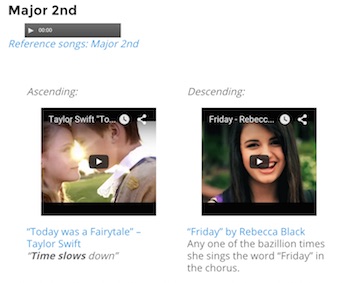 The traditional interval reference songs tend to be a bit dull. Lots of Christmas carols, folk songs, and examples from old music you may never have heard of.
The traditional interval reference songs tend to be a bit dull. Lots of Christmas carols, folk songs, and examples from old music you may never have heard of.
The good news is you certainly don’t need to limit yourself to those standard examples! You are free to use any song which starts with the interval as your reference song for that interval.
Example: Use “Friday” by Rebecca Black to remember the descending major second:
If you do a Google search for “interval reference songs” you’ll find plenty of lists to give you ideas. Here are some to get you started:
We also have our own set of modern interval reference songs.
Everybody has different musical tastes though, so if you find yourself lacking songs for certain intervals, try to figure out your own. This is a great exercise in itself:
- Play an example of the interval on your instrument, and see if any song pops into your head.
- If not, try another random example of that interval type. It can help to play the corresponding major chord first, to give your brain a harmonic context. For example play a C major chord, and then the interval starting from C.
- Try adding a random third note after the interval to help prompt your brain to fill in the rest of a tune.
- Alternatively, start from your 10 favourite songs and figure out what the corresponding interval is for each.
After exploring the links above and trying these exercises you should be able to compile your own personal list of interval reference songs for the ascending and descending form of each of the 13 intervals.
Google “interval reference songs” or follow the links above to find interval reference songs that appeal to you. Figuring out your own reference songs is a useful exercise in itself.
How can I learn intervals with solfa?
 The solfa framework for relative pitch gives each note in the scale a name: “do”, “re”, “mi”, etc. You can learn all about it in this tutorial series.
The solfa framework for relative pitch gives each note in the scale a name: “do”, “re”, “mi”, etc. You can learn all about it in this tutorial series.
So how does that relate to interval recognition? Well, the idea is that you learn the pair of note names which correspond to the interval. For example, you learn that a major third is “do mi” ascending, and that going from “la” up to “do” gives you a minor third. All the intervals have one or more handy solfa equivalents.
This means that all the practice you do recognising solfa notes by ear helps you recognise intervals and vice-versa. You can reinforce the connection by singing exercises where you sing the two notes with their solfa names, followed by those same two notes with the interval name, e.g. “do, mi, major, third”. For example:
Here are some more examples of solfa interval exercises you can practice with.
You learn the syllables which correspond, e.g. “do” up to “so” is a perfect fifth. There are exercises you can use to practice this.
How can I learn intervals by just doing it?
 To learn intervals with the “pure recognition” or “brute force” approach you need an easy way to hear lots of examples, organised into sensible groupings. For example, starting out with just ascending major and minor seconds. No other interval types included until you get the hang of those.
To learn intervals with the “pure recognition” or “brute force” approach you need an easy way to hear lots of examples, organised into sensible groupings. For example, starting out with just ascending major and minor seconds. No other interval types included until you get the hang of those.
At first you use these examples to listen carefully and try to hear the differences between different interval types. Then you can start to test yourself, by guessing the interval type and checking your answer.
You have three options here:
- Instrument Practice: Just sit with your instrument and play examples for yourself. Depending on your instrument this may require some knowledge of interval spelling but is a fantastic way to make sure you’re always relating interval recognition back to practical instrument skills. Guitarists can actually do interval ear training on guitar without knowing the spellings.
- MP3 Practice Tracks: These are MP3 files which play a series of example intervals and announce what type each was. Each MP3 typically represents a “lesson” i.e. a certain set of interval types.
For example here’s a track for ascending major and minor thirds:Here are some more free interval tracks to get you started.
- Interactive Software: You can get desktop software and mobile apps which will let you practice interval recognition in an interactive way, quizzing you on the different intervals. This can be highly customisable and convenient. There are also websites which provide online interval training and even interval ear training games like those from Theta Music.
Download some training MP3s which demonstrate and test you on recognition. Or use interactive software: there are options for web, desktop and mobile.
Do I need to master certain intervals before moving on?
There are three reasons you might think that you should progress through learning the intervals in order, mastering each before moving on.
- If you’re following a course to learn interval recognition you’ll probably find there’s a set sequence of lessons to follow.
- From a music theory perspective there is a logical ordering of the intervals by their size.
- Repetition is required for you to learn recognition skills, so you do need to persist for the brain to learn what it needs to.
However, mastery of each interval type is not necessary. It’s not necessary before moving on with your training, and it’s actually not necessary to start using intervals in your music-making either.
In fact, allowing yourself to be flexible will typically accelerate your training by letting you skirt around obstacles and sticking points. When you return to them later you normally find your improved sense of relative pitch has already removed the problem.
So don’t be afraid to move on before 100% perfect mastery of certain interval types. Aim for 80% or “normally right”, then come back later and polish up any problem spots.
Mastery is not necessary. Be persistent, because it does take time and repetition to teach the brain new skills – but if you’ve been stuck for a while, moving on to something else can actually accelerate your overall progress.
What if I get stuck learning intervals?
 Learning intervals takes time. Most musicians can get to a good intermediate level within a few months of regular practice, but that journey can feel slow-going, and going further to truly master and apply interval recognition will take patience.
Learning intervals takes time. Most musicians can get to a good intermediate level within a few months of regular practice, but that journey can feel slow-going, and going further to truly master and apply interval recognition will take patience.
So when you feel stuck, what can you do? The answer is to mix things up a bit. The wonderful thing about learning relative pitch is that the skills you practice are all complementary. So changing your approach from the straight-line you probably initially planned can actually be a good thing rather than an admission of defeat.
Here are a few examples of how to mix it up in a useful way:
- Change the instrument. Either the actual instrument you’re playing if possible, or just the instrument sound used in your training examples.
- Change your approach. If you’ve been using reference songs, give solfa a try. If you’ve been drilling hard with practice exercises maybe you’d find some reference songs helpful. And so on.
- Change the intervals you’re studying. For example, skip ahead a lesson or return to some you’d already mastered and refresh your memory and skills. Changing form from melodic to harmonic can also be a great way to keep making progress.
- Change your training, specifically by switching the kinds of exercise you do. If you’ve been doing pure practice drills, try applying your interval skills for improvisation or playing by ear, or using them to write music of your own.
Finally, if you’re making slower progress than you hoped to and you aren’t singing your intervals it’s time to start. Read on to find out why.
Need more ideas for getting unstuck? You can also check out our dedicated articles on Interval Ear Training Help and Interval Tips and Tricks.
Mix it up. Change the interval types you’re practising, change the instrument, find a new way to practice. Also, sing!
Why does singing intervals help you learn them?
When our students at Easy Ear Training and Musical U get stuck learning intervals, the first thing I always ask is: “Are you singing as part of your practice?”
It doesn’t matter if you’re “a singer” or not. If you aren’t using your voice to train your ears then you’re overlooking one of your most powerful tools.
 The brain has a deep connection to both the ears and the vocal cords, and all three work together in your musical instinct. Getting better at pitching notes with your voice means you get better and judging those pitch distances by ear too.
The brain has a deep connection to both the ears and the vocal cords, and all three work together in your musical instinct. Getting better at pitching notes with your voice means you get better and judging those pitch distances by ear too.
Singing also gives you a kind of “playground” you can use when figuring out intervals. This lets you try out different things and give your ear more to work with. For example you can transform a harmonic interval you just heard into its melodic form by singing back the two notes.
There’s an intimate biological connection between brain, ears and voice. By singing intervals you teach your brain to judge their distances in a new and effective way. Also, having accurate singing pitch makes you a better musician.
 Using Intervals
Using Intervals
How will intervals help me recognise chords and progressions?
Many musicians feel like intervals are too simple to be useful. What they actually want to do is play chords by ear, or work out melodies, or improvise solos. These all seem like more bigger musical elements than a simple pair of notes.
As explained earlier, intervals are the “building blocks” of relative pitch. That means they’re the easiest way to build up to those more sophisticated skills.
 Intervals help you recognise different types of chord (e.g. C Major vs. C Minor vs. C Seven) because you start to hear the pitch relationships between the notes of the chord. Each pair of notes in the chord is an interval and you can learn the intervals for each chord. For example, learning that a major third combined with a perfect fifth gives you a major chord.
Intervals help you recognise different types of chord (e.g. C Major vs. C Minor vs. C Seven) because you start to hear the pitch relationships between the notes of the chord. Each pair of notes in the chord is an interval and you can learn the intervals for each chord. For example, learning that a major third combined with a perfect fifth gives you a major chord.
 Intervals are also helpful for chord progressions, as they let you hear the movement of the root (base) note of the chords. For example, to recognise a C-F-G progression you hear that it sounds a bit like a perfect fourth (C up to F) and then a major second (F up to G). Or that the final chord sounds like a perfect fifth above the first one (C up to G).
Intervals are also helpful for chord progressions, as they let you hear the movement of the root (base) note of the chords. For example, to recognise a C-F-G progression you hear that it sounds a bit like a perfect fourth (C up to F) and then a major second (F up to G). Or that the final chord sounds like a perfect fifth above the first one (C up to G).
These examples are a good reminder of the fundamental point: interval recognition builds your sense of relative pitch and that’s what lets you do all the interesting and exciting activities in music.
The intervals between the notes in chords can help you recognise the chords. The intervals between the root notes of chords can help you recognise a progression. Fundamentally, intervals build your core ability to identify all the notes you hear.
How will intervals help me improvise?
 Improvisation can be thought of as the ability to imagine new music in your head and then bring it out through your instrument.
Improvisation can be thought of as the ability to imagine new music in your head and then bring it out through your instrument.
Intervals help you to improvise by letting you understand the music you imagine in concrete terms. You know how the second note relates to the first, and the third to the second, so that when you want to actually play those notes, you can. You know how far above or below each note the next one should be.
One caveat here: often people working on intervals and improvisation worry that they can’t get fast enough recognising intervals to actually use it at improvisation speed.
There are two solutions here.
The first is that as you get better and faster at interval recognition, it becomes an automatic instinct rather than a thinking process. This is related to the “innate pitch ruler” idea discussed earlier.
The second solution is that typically a musician won’t choose each note to improvise completely at random from all possible notes! They operate within a framework such as a scale. This greatly reduces the number of possible notes to those notes which will sound good and musical. Then they use interval recognition to know which notes from that framework they are choosing in their head.
When you imagine the next note you want to play, intervals let you judge how far you need to jump from your last note to hit it.
How will intervals help me play by ear?
 When you listen to music with interval-trained ears you hear in a much more structured and precise way. This means that you can apply your interval recognition skills to work out the notes you’ve heard. You can then write them down or play them on your instrument.
When you listen to music with interval-trained ears you hear in a much more structured and precise way. This means that you can apply your interval recognition skills to work out the notes you’ve heard. You can then write them down or play them on your instrument.
To play exactly the notes you heard, you generally do need one known note to base all your other relative judgements on. For example, you might look up the key of the song, or just dabble on your instrument along with the recording to identify the tonic note. Once that one note is known, all the rest follow from the intervals between them.
Like improvisation, this begins as a slow thinking process. You will really be “working out songs by ear” rather than directly playing them. But over time, and with the use of frameworks (e.g. knowing about I-IV-V chord progressions) this gets faster and faster until it’s immediate and easy.
When you hear notes in music, interval recognition lets you judge how far apart they are from one another. So once you know the identity of one note (e.g. the melody starts on a C) you can figure out all the notes by ear.
So there you have it! All the essential information about learning intervals, condensed down into bite-sized chunks.
You should now understand what intervals are and why they matter. You know which ones to focus on, and three methods for doing interval ear training. Perhaps most importantly, you know how to start using intervals in your real musical life for tasks like playing by ear, improvising, transcription and writing your own music.
Want more? You can find even more interval resources on our dedicated Intervals page or explore the interactive interval training modules available at Musical U where you can get personal help and support to create a training plan to conquer intervals in an easy, fun and effective way which perfectly fits your musical life.
Did we miss anything? If you still have unanswered questions or you want to share your own advice or interval tips, leave a comment below!

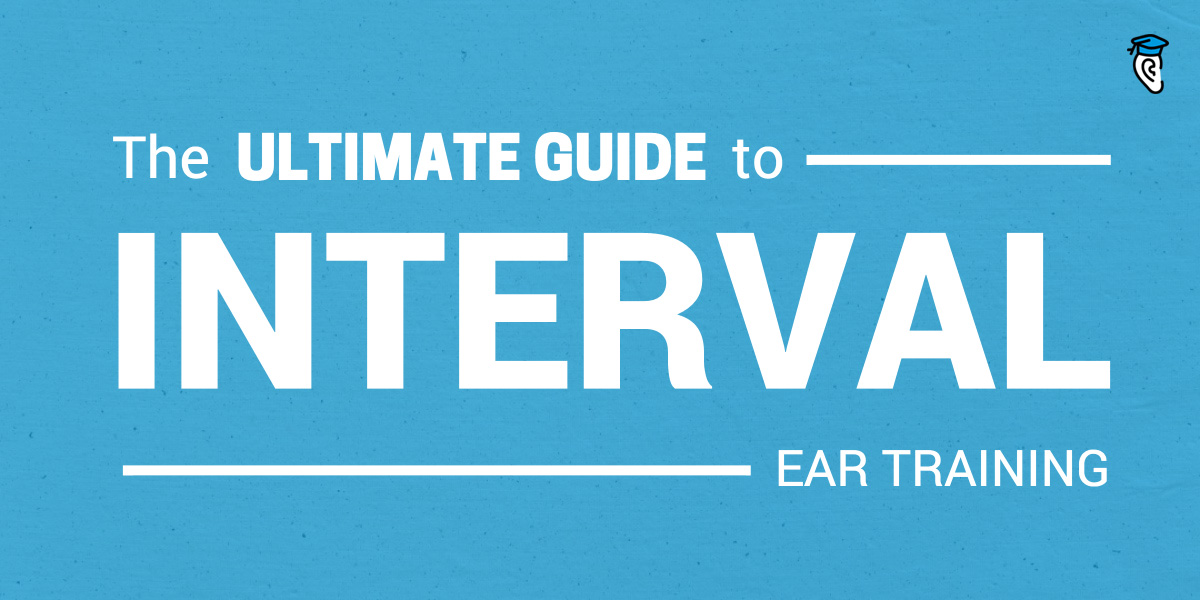

 About Intervals
About Intervals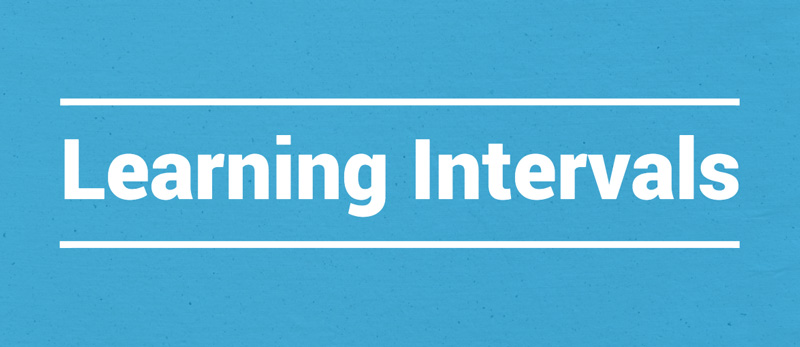 Learning Intervals
Learning Intervals By directly estimating the distance in pitch. For example, most musicians could tell you that the notes of a major sixth are further apart than the notes of a major second:
By directly estimating the distance in pitch. For example, most musicians could tell you that the notes of a major sixth are further apart than the notes of a major second:
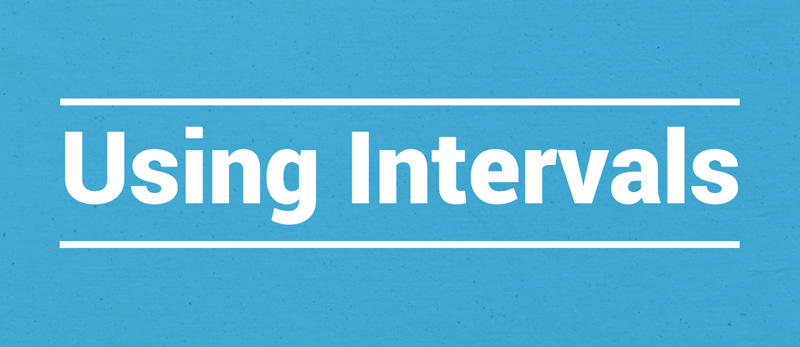 Using Intervals
Using Intervals




